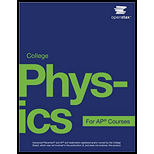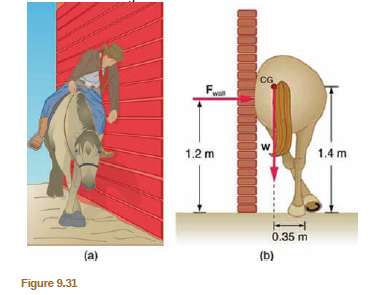
College Physics For Ap® Courses
16th Edition
ISBN: 9781938168932
Author: Gregg Wolfe, Irina Lyublinskaya, Douglas Ingram
Publisher: OpenStax
expand_more
expand_more
format_list_bulleted
Concept explainers
Textbook Question
Chapter 9, Problem 8PE
(a) Calculate the magnitude and direction of the force on each foot of the horse in Figure 9.31 (two are on the ground), assuming the center of mass of the horse is midway between the feet. The total mass of the horse and rider is 500kg. (b) What is the minimum coefficient of friction between the hooves and ground? Note that the force exerted by the wall is horizontal.

Expert Solution & Answer
Trending nowThis is a popular solution!

Students have asked these similar questions
You want to determine if a new material created for solar panels increases the amount of energy that can be captured . You have acquired 15 panels of different sizes manufactured with different materials including the new material.You decide to set up an experiment to solve this problem .What do you think are the 3 most important variables to address in your experience? How would you incorporate those materials in your experiment?
No chatgpt pls will upvote
Why can't this be correct: &= 7m?
Chapter 9 Solutions
College Physics For Ap® Courses
Ch. 9 - What can you say about the velocity of a moving...Ch. 9 - Under what conditions can a rotating body be in...Ch. 9 - What three factors affect the torque created by a...Ch. 9 - A wrecking ball is being used to knock down a...Ch. 9 - Mechanics put a length of Pipe over the handle of...Ch. 9 - A round pencil lying on its side as in Figure 9.13...Ch. 9 - Explain the need for tall towers on a suspension...Ch. 9 - When visiting some countries, you may see a person...Ch. 9 - Scissors are like a double-lever "Stem, Which of...Ch. 9 - Suppose you pull a nail at a constant rate using a...
Ch. 9 - Why are the forces exerted on the outside world by...Ch. 9 - Explain why the forces in our joints are several...Ch. 9 - Why are the forces exerted on the outside world by...Ch. 9 - Explain why the forces in our joints are several...Ch. 9 - Certain of dinosaurs were bipedal (walked on two...Ch. 9 - Swimmers and athletes during competition need to...Ch. 9 - If the maximum force the biceps muscle can exert...Ch. 9 - Suppose the biceps muscle was attached through...Ch. 9 - Explain one of the reasons why pregnant women...Ch. 9 - (a) When opening a door, you push on it...Ch. 9 - When tightening a bolt, you push perpendicularly...Ch. 9 - Two children push on opposite sides of a door...Ch. 9 - Use the second condition for equilibrium (net =0 )...Ch. 9 - Repeat the seesaw problem in Example 9.1 with the...Ch. 9 - Suppose a horse leans against a wall as in Figure...Ch. 9 - Two children of mass 20.0 kg and 30.0 kg sit...Ch. 9 - (a) Calculate the magnitude and direction of the...Ch. 9 - A person carries a plank of wood 2.00 m long with...Ch. 9 - A 17.0-m-high and 11.0-m-long wall under...Ch. 9 - (a) What force must be exerted by the wind to...Ch. 9 - Suppose the weight of the drawbridge in Figure...Ch. 9 - Suppose a 900-kg car is on the bridge in Figure...Ch. 9 - A sandwich board advertising sign is constructed...Ch. 9 - (a) What minimum coefficient of friction is needed...Ch. 9 - A gymnast is attempting to perform splits. From...Ch. 9 - To get up on the roof, a person (mass 70.0 kg)...Ch. 9 - In Figure 9.21, the cg of the pole held by the...Ch. 9 - What is the mechanical advantage of a nail puller...Ch. 9 - Suppose you needed to raise a 250-kg mower a...Ch. 9 - a) What is the mechanical advantage of a...Ch. 9 - A typical car has an axle with 1.10 cm radius...Ch. 9 - What force does the nail puller in Exercise 9.19...Ch. 9 - If you used an ideal pulley of the type shown in...Ch. 9 - Repeat Exercise 9.24 for the pulley shown in...Ch. 9 - Verity that the force in the elbow joint in...Ch. 9 - Two muscles in the back of the leg pull on the...Ch. 9 - The upper leg muscle (quadriceps) exerts a force...Ch. 9 - A device for exercising the upper leg muscle is...Ch. 9 - A person working at a drafting board may hold her...Ch. 9 - We analyzed the biceps muscle example with the...Ch. 9 - Even when the head is held erect, as in Figure...Ch. 9 - A 75-kg man stands on his toes by exerting an...Ch. 9 - A father lifts his child as shown in Figure 9.43....Ch. 9 - Unlike most of the other muscles in our bodies,...Ch. 9 - Integrated Concepts Suppose we replace the 4.0-kg...Ch. 9 - (a) What force should the woman in Figure 9.45...Ch. 9 - You have just planted a sturdy 2-m-tall palm tree...Ch. 9 - Unreasonable Results Suppose two children are...Ch. 9 - Construct Your Own Problem Consider a method for...
Additional Science Textbook Solutions
Find more solutions based on key concepts
1. A cyclist goes around a level, circular track at constant speed. Do you agree or disagree with the following...
College Physics: A Strategic Approach (3rd Edition)
An elevator suspended by a cable is descending at constant velocity. How many force vector would be shown on ...
Physics for Scientists and Engineers: A Strategic Approach, Vol. 1 (Chs 1-21) (4th Edition)
An atom with a formal charge does not necessarily have more or less electron density than the atoms in the mole...
Organic Chemistry (8th Edition)
DRAW IT An artificial "cell" consisting of an aqueous solution enclosed in a selectively permeable membrane is ...
Campbell Biology (11th Edition)
Some organizations are starting to envision a sustainable societyone in which each generation inherits sufficie...
Campbell Essential Biology (7th Edition)
Q2. A graduated cylinder has markings every milliliter. Which measurement is accurately reported for this gradu...
Introductory Chemistry (6th Edition)
Knowledge Booster
Learn more about
Need a deep-dive on the concept behind this application? Look no further. Learn more about this topic, physics and related others by exploring similar questions and additional content below.Similar questions
- give a brief definition of the word "paradigm" as well as an example of a current scientific paradigmarrow_forward7. Are all scientific theories testable in the commonly understood sense? How does this make you feel? How should you proceed as a scientist or engineer with this understanding?arrow_forwardWhat is an an example of a hypothesis that sounds scientific but is notarrow_forward
- What is an example of a scientific hypothesisarrow_forwardMultiverse is called a theory. It has been proposed to account for the apparent and uncanny fine tuning of our own universe. The idea of the multiverse is that there are infinite, distinct universes out there - all with distinct laws of nature and natural constants - and we live in just one of them. Using the accepted definition of the universe being all that there is (matter, space and energy), would you say that multiverse is a scientific theory?arrow_forwardHow is a law usually different than a theoryarrow_forward
- A 1.50 mLmL syringe has an inner diameter of 5.00 mmmm, a needle inner diameter of 0.270 mmmm, and a plunger pad diameter (where you place your finger) of 1.2 cmcm. A nurse uses the syringe to inject medicine into a patient whose blood pressure is 140/100. Part A What is the minimum force the nurse needs to apply to the syringe? Express your answer with the appropriate units. View Available Hint(s)for Part A Hint 1for Part A. How to approach the question The force the nurse applies to the syringe can be determined from the fluid pressure and the area of the plunger. The minimum force corresponds to the patient's lowest blood pressure. Use the following equality 760mmofHg=1atm=1.013×10^5Pa760mmofHg=1atm=1.013×10^5Pa.arrow_forwardA 1.50 mLmL syringe has an inner diameter of 5.00 mmmm, a needle inner diameter of 0.270 mmmm, and a plunger pad diameter (where you place your finger) of 1.2 cmcm. A nurse uses the syringe to inject medicine into a patient whose blood pressure is 140/100. Part A What is the minimum force the nurse needs to apply to the syringe? Express your answer with the appropriate units. View Available Hint(s)for Part A Hint 1for Part A. How to approach the question The force the nurse applies to the syringe can be determined from the fluid pressure and the area of the plunger. The minimum force corresponds to the patient's lowest blood pressure. Use the following equality 760mmofHg=1atm=1.013×10^5Pa760mmofHg=1atm=1.013×10^5Pa.arrow_forwardIs a scientific theory supposed to just be someone's idea about somethingarrow_forward
- what is the agenda of physicsarrow_forwardWatch the video of Cooper’s play, while conducting and documenting your observation using a chosen observation tool. Case Study 1b - Cooper Carol has asked you to support the babies and toddler’s room educators this week. She has requested that you complete an observation on Cooper, who is a 10-month-old toddler. Carol wants to see how well you conduct an observation and is interested in how you manage to communicate in any observations made, using a strengths-based, non-judgemental, anti-biased approach, as this is a fundamental part of creating a supportive and respectful culture at Little Catalysts ELC. Video: Cooper's play (6:45 min) Resources Module 7 eLearns Template: Learning story observation, Section 1 Template: Running record observation, Section 1 Template: Anecdotal record observation, Section 1 Video: Cooper's play (6:45 min) Complete and upload an observation of Cooper to support educators in future curriculum planning. Choose one (1) of the observation…arrow_forward1. An ideal gas is taken through a four process cycle abcda. State a has a pressure of 498,840 Pa. Complete the tables and plot/label all states and processes on the PV graph. Complete the states and process diagrams on the last page. Also, provide proper units for each column/row heading in the tables. Pressure (Pa) 500,000 450,000 400,000 350,000 300,000 250,000 200,000 150,000 100,000 Process ab bc cd da States P( ) V( ) 50,000 0 0.000 T = 500 K T= 200 K 0.001 0.002 0.003 0.004 0.005 Volume (m^3) Nature of Process isothermal expansion to Vb = 0.005 m³ (T = 500 K) isometric isothermal compression to V₁ = 0.003 m³ (T = 200 K) adiabatic compression to VA = 0.001 m³ b C a T() U ( ) Processes a-b Q( ) +802.852 W() AU ( ) b-c c→d +101.928 da Cyclearrow_forward
arrow_back_ios
SEE MORE QUESTIONS
arrow_forward_ios
Recommended textbooks for you
 Principles of Physics: A Calculus-Based TextPhysicsISBN:9781133104261Author:Raymond A. Serway, John W. JewettPublisher:Cengage Learning
Principles of Physics: A Calculus-Based TextPhysicsISBN:9781133104261Author:Raymond A. Serway, John W. JewettPublisher:Cengage Learning University Physics Volume 1PhysicsISBN:9781938168277Author:William Moebs, Samuel J. Ling, Jeff SannyPublisher:OpenStax - Rice University
University Physics Volume 1PhysicsISBN:9781938168277Author:William Moebs, Samuel J. Ling, Jeff SannyPublisher:OpenStax - Rice University College PhysicsPhysicsISBN:9781938168000Author:Paul Peter Urone, Roger HinrichsPublisher:OpenStax College
College PhysicsPhysicsISBN:9781938168000Author:Paul Peter Urone, Roger HinrichsPublisher:OpenStax College Physics for Scientists and Engineers: Foundations...PhysicsISBN:9781133939146Author:Katz, Debora M.Publisher:Cengage Learning
Physics for Scientists and Engineers: Foundations...PhysicsISBN:9781133939146Author:Katz, Debora M.Publisher:Cengage Learning Classical Dynamics of Particles and SystemsPhysicsISBN:9780534408961Author:Stephen T. Thornton, Jerry B. MarionPublisher:Cengage Learning
Classical Dynamics of Particles and SystemsPhysicsISBN:9780534408961Author:Stephen T. Thornton, Jerry B. MarionPublisher:Cengage Learning Stars and Galaxies (MindTap Course List)PhysicsISBN:9781337399944Author:Michael A. SeedsPublisher:Cengage Learning
Stars and Galaxies (MindTap Course List)PhysicsISBN:9781337399944Author:Michael A. SeedsPublisher:Cengage Learning

Principles of Physics: A Calculus-Based Text
Physics
ISBN:9781133104261
Author:Raymond A. Serway, John W. Jewett
Publisher:Cengage Learning

University Physics Volume 1
Physics
ISBN:9781938168277
Author:William Moebs, Samuel J. Ling, Jeff Sanny
Publisher:OpenStax - Rice University

College Physics
Physics
ISBN:9781938168000
Author:Paul Peter Urone, Roger Hinrichs
Publisher:OpenStax College

Physics for Scientists and Engineers: Foundations...
Physics
ISBN:9781133939146
Author:Katz, Debora M.
Publisher:Cengage Learning

Classical Dynamics of Particles and Systems
Physics
ISBN:9780534408961
Author:Stephen T. Thornton, Jerry B. Marion
Publisher:Cengage Learning

Stars and Galaxies (MindTap Course List)
Physics
ISBN:9781337399944
Author:Michael A. Seeds
Publisher:Cengage Learning